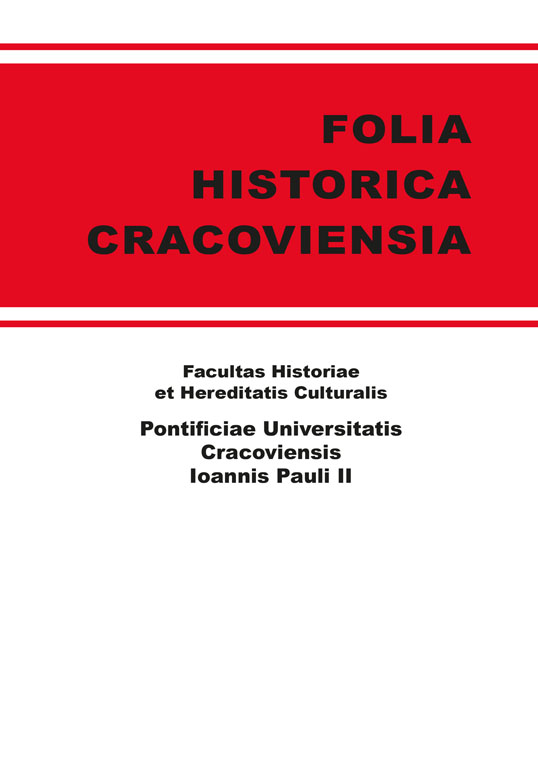Rabacja chłopska 1846 roku w relacji ks. Jana Popławskiego z Niegowici
The peasant slaughter of 1846 in the accounts of father Jan Popławski of Niegowić
Author(s): Ewa DanowskaSubject(s): History, Modern Age, 19th Century
Published by: Wydawnictwo Naukowe Uniwersytetu Papieskiego Jana Pawła II w Krakowie
Keywords: 1846;Galicia;Niegowic;Peasants;Rebelion
Summary/Abstract: Ocena wydarzeń z 1846 roku była różna w ocenie urzędowej austriackiej i patriotycznej polskiej. Według tej pierwszej wersji rzeź galicyjska była odruchem wierności włościan wobec monarchii austriackiej, potępiającym próbę powstania przeciw cesarzowi. Z polskiej strony rabację potraktowano jako skutek świadomej prowokacji dokonanej przez biurokrację austriacką, trafiającej na podatny grunt niechęci pańszczyźnianych chłopów wobec szlachty. Rabacja położyła kres przygotowaniom do narodowego powstania. Rozprzestrzeniła się w zachodniej Galicji, głównie w okolicach Tarnowa, Bochni i Jasła. Tzw. „krwawe zapusty” rozpoczęte ok. 19 lutego 1846 roku pochłonęły wiele ofiar. Chłopi napadali na dwory i plebanie w poszukiwaniu powstańców i broni, bili i mordowali dziedziców i ich oficjalistów, demolowali budynki, rabowali wyposażenie dworów i zabudowań gospodarczych.Z tego okresu zachowały się relacje i wspomnienia, wśród nich relacja ks. Jana Popławskiego (1800–1892), ówczesnego proboszcza w Niegowici. Swoje wspomnienia spisał w 1857 roku, dla rodziny. Ich oryginał znajduje się w Bibliotece Naukowej PAU i PAN w Krakowie, podarowany w 1925 roku przez Seweryna Udzielę. Wspomnienia ks. Popławskiego z 22–24 lutego 1846 roku obejmują tylko 3 dni rabacji, mimo to są cenne jako kronikarski zapis wydarzeń w Niegowici i najbliższej okolicy. Zawierają też osobiste odczucia i komentarze autora wspomnień. /The evaluation of the events of 1846 differed in the opinions of Austrian officialdom and patriotic Poland. According to the version as assessed by the former, the Galician massacre was a reflex on the part of the peasantry loyal to the Austrian monarchy and condemning the uprising against the emperor. From the Polish side, it was viewed as the result of conscious provocation, on the part a bureaucratic Austria, which fell on the fertile ground of the villein peasants’ malevolence toward the nobility and gentry. The slaughter put an end to the preparation for a national uprising. It spread through Western Galicia, primarily in the environs of Tarnów, Bochnia and Jasło. What has been dubbed ‘the bloody carnival’, which was launched around 19th February 1846, engulfed countless victims. The peasants fell on manor houses and presbyteries in search of insurgents and weapons, beating and murdering the country gentry and their clerks, demolishing buildings and robbing the manors and their farm outbuildings of furnishings and fittings.Accounts and memoirs of that period have survived, amongst them those of Father Jan Popławski (1800–1892), the then parish priest of Niegowić. He wrote them for his family in 1857. The original, held in the Academic Library of the Polish Academy of Arts and Sciences and the Polish Academy of Sciences in Krakow, was gifted by Seweryn Udziela in 1925. Father Popławski’s memoirs cover 22nd to 24th February 1846, encompassing only three days of the slaughter. For all that, they are valuable as a chronicler’s record of events in Niegowić and its closest environs. They also contain the personal feelings and commentaries of their author.
Journal: Folia Historica Cracoviensia
- Issue Year: 19/2013
- Issue No: 1
- Page Range: 223-246
- Page Count: 23
- Language: Polish

